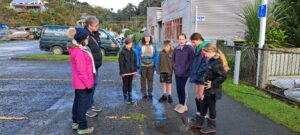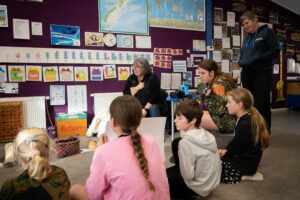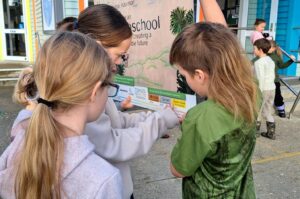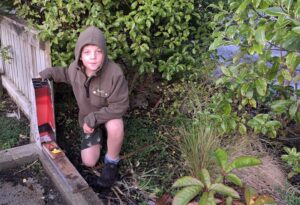
Regional Coordinator of Enviroschools Southland, Josh Sullivan, discusses what the Guiding Principles look like in Rakiura with students.
Tamariki at Te Kura O Rakiura are adventurous, self-reliant and thrive in nature – traits that have led to the school becoming Aotearoa New Zealand’s southernmost Green-Gold Enviroschool.
Nestled in the heart of Halfmoon Bay, Rakiura Stewart Island, the school recently celebrated its Green-Gold reflection with teachers, the community, Enviroschools facilitators and its 40 students, who have demonstrated visionary thinking and that they care wholeheartedly for their pristine environment.
“We live in such a beautiful place. It’s important we look after the wildlife and nature,” says Sayla, a Year 7 student.
As kaitiaki, students have a strong sense of connection to the land. This connection, and student-led initiatives like their rat trapping programme, have taken the school from the Silver reflection stage to Green-Gold.
The Enviroschools programme offers three key reflection stages – Bronze, Silver and Green-Gold. The Green-Gold reflection stage allows Enviroschools to describe their experiences as they increase actions and practices on their journey towards a sustainable world. After completing the holistic reflection process, the school may choose to be officially recognised as a ‘Green-Gold Enviroschool’, celebrating their past, present and future journey.

Checking out the storm-water fish – only rain should go down the drain.
Underpinning the Enviroschools approach are five Guiding Principles – Ngā Mātāpono woven into all aspects of school life. Those principles are empowered students, sustainable communities, learning for sustainability, te ao Māori, and respect for the diversity of people and cultures.
Principal Kath Johnson says the recognition is a nice celebration of the mahi children, teachers, and the Rakiura community have achieved together.
“We are still on our journey and improving the Kura every day. Empowering students is incredibly important to us and for them to take responsibility for their learning.” – Kath Johnson, Principal
One area we’ve really improved is incorporating Māori perspectives into our school culture. We’ve done this through our greeting and welcome practices, karakia, and increased awareness and visibility of tikanga, says Kath.
“We are fortunate to have such an engaged community who support us on our journey, care about the environment and are always willing to be involved.” – Kath Johnson, Principal

Hand on heart we know we are a Green-Gold Enviroschool!
The school’s Green-Gold sharing day, held on a chilly day in late June, was led by students and Enviroschools facilitators from Environment Southland. The students spent the morning talking about their learning, actions and initiatives to demonstrate how the five guiding principles were a part of everything they do.
Many of these successful student-led initiatives, such as the penguin monitoring cameras and Kura kai garden, focus on sustainable communities with measurable actions to make a difference.
Following the Enviroschools framework, students reflected upon their achievements to decide ‘hand-on-heart’ if they are a Green-Gold Enviroschool. The answer from students was a resounding – yes!
Year 8 student, Ava, says the Green-Gold recognition is great for the school as it means they are doing great across all guiding principles, especially Māori perspectives.
“I’m most proud of the kai garden because we sold seedlings from this garden to the community, and it felt like we were giving back.”- Ava

Students attach the Green-Gold sticker to their sign.
The penguin camera project was set up to monitor penguin activity and the population at Ackers Point. Students got curious and wondered if there were Little Blue Penguins at the local wharf, and are now monitoring that spot, says Ava.
As part of the penguin project, tamariki visited the hoiho rehabilitation facility at Mamaku Point Predator Free Sanctuary. Students learnt about penguins and their habitats and created artwork inspired by their visit.
Bevan Mudie, the school’s volunteer art teacher says they create artwork to celebrate the island’s culture and wildlife.
“I think we’ve well and truly drawn or painted every animal on the island. Working with the school and students is a wonderful way for me to get to know the whole community, and it’s a nice contribution that I can make to the life of the school.” – Bevan Mudie, volunteer
Bevan says the teachers have done a wonderful job of supporting the students to think about their lives and the impact their decisions have on the environment.
Monitoring pests is one of the many actions students take to care for their environment.

Re-setting the rat traps as part of predator control around the school.